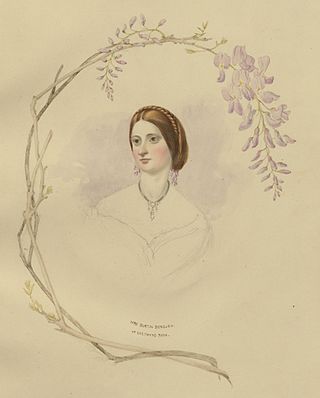
Francis Perceval Eliot was an English soldier, auditor, and man of letters. In 1814 he succeeded his half-brother as Count Eliot, however he did not feel it was proper to assume the title.

Sir Robert Taylor (1714–1788) was an English architect and sculptor who worked in London and the south of England.

Great Haywood is a village in central Staffordshire, England, just off the A51 and about 4.5 miles (7.2 km) northwest of Rugeley and 7.1 miles (11.4 km) southeast of the county town of Stafford. Population details taken at the 2011 census can be found under Colwich.

Beaudesert was an estate and stately home on the southern edge of Cannock Chase in Staffordshire. It was one of the family seats of the Paget family, the Marquesses of Anglesey. The estate was obtained by William Paget, 1st Baron Paget in 1546; the family's other main seat is at Plas Newydd.

Beacon Park is a public park in the centre of the city of Lichfield, Staffordshire, in England. The park was created in 1859 when the Museum Gardens were laid out adjacent to the newly built Free Museum and Library. The park has since been extended in stages and now forms 69 acres (28 ha) of open parkland in the city centre. The park is in the northwest of the city centre and to the west of the Cathedral Close across the road from the Garden of Remembrance.
Sir Theophilus Biddulph, 1st Baronet was the son of Michael Biddulph of Elmhurst, Staffordshire.
Sir Michael Biddulph, 2nd Baronet, of Elmshurst, Staffordshire and Westcombe, Kent, was an English Whig politician who sat in the English and British House of Commons between 1679 and 1710.

George Harry Booth-Grey, 7th Earl of Stamford and 3rd Earl of Warrington was an English cricketer, landowner and peer, who sat on the Whig benches in the House of Lords.
This is a list of the sheriffs and high sheriffs of Staffordshire.

Swinfen Hall is an 18th-century country mansion house, now converted into a hotel, situated at Swinfen, in the Lichfield district of Staffordshire in England. It is a Grade II* listed building.

Dunstall Hall is a privately owned 18th century mansion house near Tatenhill, Burton upon Trent, Staffordshire. It is a Grade II* listed building.

Croxall Hall is a restored and extended 16th century manor house situated in the small village of Croxall, Staffordshire. It is a Grade II* listed building.

The Chetwynd Park estate lies in the small village of Chetwynd on the outskirts of the town of Newport, Shropshire, England. The estate is positioned in a gap north of Newport, where the road having crossed the marshland, clings to a steep slope of the Scaur above the meadowlands of the River Meese, where it meets Lonco Brook, before widening out onto the north Shropshire plain.

Curborough and Elmhurst is a civil parish in Lichfield District, Staffordshire, England. The hamlets of Curborough and Elmhurst, that make up the parish, lie just north of the City of Lichfield, and are separated from each other by the West Coast Main Line. The parish council is a joint one with Farewell and Chorley. Curborough's name derives from Old English. The words for mill stream in Old English were 'cweorn burna,' and likely referred to Curborough brook.

The Franciscan Friary was once a large estate located on the west side of Lichfield city centre in Staffordshire. The estate was built and inhabited by the Franciscan Friars from 1237. At one time the estate consisted of a large church, a cloister, dormitory lodge and a refectory building as well as many other domestic dwellings.
Teddesley Hall was a large Georgian English country house located close to Penkridge in Staffordshire, now demolished. It was the main seat firstly of the Littleton Baronets and then of the Barons Hatherton. The site today retains considerable traces of the hall, gardens and other buildings, while the former home farm remains a working farm.

Chell is a suburb of the city of Stoke-on-Trent in the ceremonial county of Staffordshire, England, that can be subdivided into Little Chell, Great Chell and Chell Heath. It lies on the northern edge of the city, approximately 1-mile (1.6 km) from Tunstall, 2 miles (3.2 km) from Burslem and 3 miles (4.8 km) from the county border with Cheshire. Chell borders Pitts Hill to the west, Tunstall to the south west, Stanfield and Bradeley to the south, with the outlying villages of Packmoor and Brindley Ford to the north and Ball Green to the east. Since 2011 the area has been divided into the electoral wards of Bradeley & Chell Heath, Great Chell & Packmoor and Little Chell & Stanfield.

Lieutenant-Colonel Michael Alexander Wilsone Swinfen-Broun JP (1858–1948) was a soldier, magistrate, High Sheriff and Deputy Lieutenant of Staffordshire, and benefactor of the city of Lichfield, England, where he lived at Swinfen Hall.

Margaret Bromleynée Lowe was a noted English Puritan of Staffordshire origins. She married Sir Edward Bromley, a noted lawyer and judge of the period. After his death she established a base for sheltering and supporting nonconforming ministers at Sheriffhales. Leaving the area during the English Civil War, she spent the final years of her life at Loughborough.















